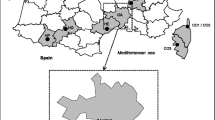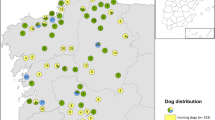Abstract
Purpose
The aim of this study was to evaluate the prevalence and distribution of canine babesiosis and hepatozoonosis in the south of Romania as well as to assess if there are differences in the prevalence between regions in that area.
Methods
Blood samples from 300 dogs from the south of Romania were screened for the presence of piroplasmids by PCR. Positive samples were further tested for the presence of Babesia spp. and Hepatozoon canis. Pearson's chi-square with Yates correction was used to determine if there is statistical difference between infected populations.
Results
Fifty-four percent (163/300) of the dogs were positive for Hepatozoon spp. or piroplasmids. Forty-eight percent (143/300) were infected with H. canis and 9.6% (29/300) were positive to B. canis. Three percent (9/300) of the dogs were co-infected with Babesia spp. and H. canis. The prevalence of H. canis in the south-west of Romania was significantly higher (p < 0.05) than that of three other regions while the prevalence of Babesia spp. infection in the south-east of the country was significantly higher (p < 0.05) compared to its south-west.
Conclusions
A high rate of H. canis infection was found in the stray dog population surveyed with the highest infection rate detected in south-western Romania. Babesia canis was found to pose the highest threat in south-eastern Romania, whereas B. vogeli infection was focused in the same region of high H. canis infection in south-western Romania. These infections should be of important concern to veterinarians and dog owners in Romania.



Similar content being viewed by others
Availability of Data and Materials
All the data supporting the conclusions of this article are available within the article. The sequences obtained in this study are available in GenBank under the accession numbers MN540616–MN540630.
References
Alho AM, Lima C, Latrofa MS, Colella V, Ravagnan S, Capelli G, Madeira De Carvalho L, Cardoso L, Otranto D (2017) Molecular detection of vector-borne pathogens in dogs and cats from Qatar. Parasites Vectors 10:298. https://doi.org/10.1186/s13071-017-2237-y
Otranto D, Capelli G, Genchi C (2009) Changing distribution patterns of canine vector borne diseases in Italy: leishmaniosis vs. dirofilariosis. Parasites Vectors 2(Suppl 1):S2. https://doi.org/10.1186/1756-3305-2-S1-S2
Khasnis AA, Nettleman MD (2005) Global warming and infectious disease. Arch Med Res 36:689–696. https://doi.org/10.1016/j.arcmed.2005.03.041
Tiškina V, Jokelainen P (2017) Vector-borne parasitic infections in dogs in the Baltic and Nordic countries: a questionnaire study to veterinarians on canine babesiosis and infections with Dirofilaria immitis and Dirofilaria repens. Vet Parasitol 244:7–11. https://doi.org/10.1016/j.vetpar.2017.07.012
Øines Ø, Storli K, Brun-Hansen H (2010) First case of babesiosis caused by Babesia canis canis in a dog from Norway. Vet Parasitol 171:350–353. https://doi.org/10.1016/j.vetpar.2010.03.024
Stensvold CR, Al Marai D, Andersen LOB, Krogfelt KA, Jensen JS, Larsen KS, Nielsen HV (2015) Babesia spp. and other pathogens in ticks recovered from domestic dogs in Denmark. Parasites Vectors 8:262. https://doi.org/10.1186/s13071-015-0843-0
Morchón R, Carretón E, González-Miguel J, Mellado-Hernández I (2012) Heartworm disease (Dirofilaria immitis) and their vectors in Europe—new distribution trends. Front Physiol 3:196. https://doi.org/10.3389/fphys.2012.00196
Greene C (2012) Infectious diseases of the dog and cat, 4th edn. Missouri, Elsevier Saunders, pp 771–784
Greene C (2012) Infectious disease of the dog and cat, 4th edn. Missouri, Elsevier Saunders, pp 750–757
Margalit Levi M, Nachum-Biala Y, King R, Baneth G (2018) A survey of Babesia spp. and Hepatozoon spp. in wild canids in Israel. Parasites Vectors 11:150. https://doi.org/10.1186/s13071-018-2715-x
Ionita M, Mitrea IL, Pfister K, Hamel D, Buzatu CM, Silaghi C (2012) Canine babesiosis in Romania due to Babesia canis and Babesia vogeli: a molecular approach. Parasitol Res 110:1659–1664. https://doi.org/10.1007/s00436-011-2683-y
Hamel D, Silaghi C, Lescai D, Pfister K (2012) Epidemiological aspects on vector-borne infections in stray and pet dogs from Romania and Hungary with focus on Babesia spp. Parasitol Res 110:1537–1545. https://doi.org/10.1007/s00436-011-2659-y
Imre M, Farkas R, Ilie MS, Imre K, Dǎrǎbuş G (2013) Survey of babesiosis in symptomatic dogs from Romania: occurrence of Babesia gibsoni associated with breed. Ticks Tick Borne Dis 4:500–502. https://doi.org/10.1016/j.ttbdis.2013.06.006
Imre M, Farkas R, Ilie M, Imre K, Hotea I, Morariu S, Morar D, Dărăbuş G (2013) Seroprevalence of Babesia canis infection in clinically healthy dogs from western Romania. J Parasitol 99:161–163. https://doi.org/10.1645/GE-3129.1
Andersson M, Turcitu MA, Stefanache M, Tamba P, Barbuceanu F, Chitimia L (2013) First evidence of Anaplasma platys and Hepatozoon canis co-infection in a dog from Romania—a case report. Ticks Tick Borne Dis 4:317–319. https://doi.org/10.1016/j.ttbdis.2012.12.006
Imre M, Dudu A, Ilie MS, Morariu S, Imre K, Dărăbuş G (2015) Molecular survey of Hepatozoon canis in Red Foxes (Vulpes vulpes) from Romania. J Parasitol 101:490–491. https://doi.org/10.1645/15-732.1
Mitková B, Hrazdilová K, D’Amico G, Duscher GG, Suchentrunk F, Forejtek P, Gherman CM, Matei IA, Ionicǎ AM, Daskalaki AA, Mihalca AD, Votýpka J, Hulva P, Modrý D (2017) Eurasian golden jackal as host of canine vector-borne protists. Parasites Vectors 10:183. https://doi.org/10.1186/s13071-017-2110-z
Andersson MO, Tolf C, Tamba P, Stefanache M, Waldenström J, Dobler G, Chitimia-Dobler L (2017) Canine tick-borne diseases in pet dogs from Romania. Parasites Vectors 10:155. https://doi.org/10.1186/s13071-017-2092-x
Tabar MD, Altet L, Francino O, Sánchez A, Ferrer L, Roura X (2008) Vector-borne infections in cats: molecular study in Barcelona area (Spain). Vet Parasitol 151:332–336. https://doi.org/10.1016/j.vetpar.2007.10.019
Olmeda AS, Armstrong PM, Rosenthal BM, Valladares B, Del Castillo A, De Armas F, Miguelez M, González A, Rodríguez Rodríguez JA, Spielman A, Telford SR (1997) Short report: a subtropical case of human babesiosis. Acta Trop 67:229–234. https://doi.org/10.1016/S0001-706X(97)00045-4
Almeida AP, Marcili A, Leite RC, Nieri-Bastos FA, Domingues LN, Martins JR, Labruna MB (2012) Coxiella symbiont in the tick Ornithodoros rostratus (Acari: Argasidae). Ticks Tick Borne Dis 3:203–206. https://doi.org/10.1016/j.ttbdis.2012.02.003
Karagenc TI, Pasa S, Kirli G, Hosgor M, Bilgic HB, Ozon YH, Atasoy A, Eren H (2006) A parasitological, molecular and serological survey of Hepatozoon canis infection in dogs around the Aegean coast of Turkey. Vet Parasitol 135:113–119. https://doi.org/10.1016/j.vetpar.2005.08.007
Allen KE, Li Y, Kaltenboeck B, Johnson EM, Reichard MV, Panciera RJ, Little SE (2008) Diversity of Hepatozoon species in naturally infected dogs in the southern United States. Vet Parasitol 154:220–225. https://doi.org/10.1016/j.vetpar.2008.03.027
Baneth G, Sheiner A, Eyal O, Hahn S, Beaufils JP, Anug Y, Talmi-Frank D (2013) Redescription of Hepatozoon felis (Apicomplexa: Hepatozoidae) based on phylogenetic analysis, tissue and blood form morphology, and possible transplacental transmission. Parasites Vectors 6:102. https://doi.org/10.1186/1756-3305-6-102
Rozas J, Ferrer-Mata A, Sanchez-DelBarrio JC, Guirao-Rico S, Librado P, Ramos-Onsins SE, Sanchez-Gracia A (2017) DnaSP 6: DNA sequence polymorphism analysis of large data sets. Mol Biol Evol 34:3299–3302. https://doi.org/10.1093/molbev/msx248
Tamura K (1992) Estimation of the number of nucleotide substitutions when there are strong transition-transversion and G+C-content biases. 1. Mol Biol Evol 9:678–687
Hasegawa M, Kishino H, Yano T (1985) Dating of the human-ape splitting by a molecular clock of mitochondrial DNA. J Mol Evol 22:160–174. https://doi.org/10.1007/BF02101694
Kumar S, Stecher G, Li M, Knyaz C, Tamura K (2018) MEGA X: molecular evolutionary genetics analysis across computing platforms. Mol Biol Evol 35:1547–1549. https://doi.org/10.1093/molbev/msy096
Aktas M, Özübek S, Altay K, Balkaya I, Utuk AE, Kirbas A, Şimsek S, Dumanli N (2015) A molecular and parasitological survey of Hepatozoon canis in domestic dogs in Turkey. Vet Parasitol 209:264–267. https://doi.org/10.1016/j.vetpar.2015.02.015
Hornok S, Tánczos B, Fernández de Mera IG, de la Fuente J, Hofmann-Lehmann R, Farkas R (2013) High prevalence of Hepatozoon-infection among shepherd dogs in a region considered to be free of Rhipicephalus sanguineus. Vet Parasitol 196:189–193. https://doi.org/10.1016/j.vetpar.2013.02.009
Vojta L, Mrljak V, Ćurković S, Živičnjak T, Marinculić A, Beck R (2009) Molecular epizootiology of canine hepatozoonosis in Croatia. Int J Parasitol 39:1129–1136. https://doi.org/10.1016/j.ijpara.2009.02.007
Otranto D, Dantas-Torres F, Weigl S, Latrofa MS, Stanneck D, Decaprariis D, Capelli G, Baneth G (2011) Diagnosis of Hepatozoon canis in young dogs by cytology and PCR. Parasites Vectors 4:55. https://doi.org/10.1186/1756-3305-4-55
Guo H, Sevinc F, Ceylan O, Sevinc M, Ince E, Gao Y, Moumouni PFA, Liu M, Efstratiou A, Wang G, Cao S, Zhou M, Jirapattharasate C, Ringo AE, Zheng W, Xuan X (2017) A PCR survey of vector-borne pathogens in different dog populations from Turkey. Acta Parasitol 62:533–540. https://doi.org/10.1515/ap-2017-0064
Gabrielli S, Otašević S, Ignjatović A, Savić S, Fraulo M, Arsić-Arsenijević V, Momčilović S, Cancrini G (2015) Canine Babesioses in noninvestigated areas of Serbia. Vector Borne Zoonotic Dis 15:535–538. https://doi.org/10.1089/vbz.2015.1797
Croitoru AE, Piticar A, Burada DC (2016) Changes in precipitation extremes in Romania. Quat Int 415:325–335. https://doi.org/10.1016/j.quaint.2015.07.028
Sandu I, Pescaru VI, Poiană I, Geicu A, Cândea I (2008) Clima României (in Romanian). Editura Academiei Romane
Cruz-Vazquez C, Garcia-Vazquez Z (1999) Seasonal distribution of Rhipicephalus sanguineus ticks (Acari: Ixodidae) on dogs in an urban area of Morelos, Mexico. Exp Appl Acarol 23:277–280. https://doi.org/10.1023/A:1006075232455
Hornok S, Farkas R (2009) Influence of biotope on the distribution and peak activity of questing ixodid ticks in Hungary. Med Vet Entomol 23:41–46. https://doi.org/10.1111/j.1365-2915.2008.00768.x
Andersson MO, Tolf C, Tamba P, Stefanache M, Radbea G, Rubel F, Waldenström J, Dobler G, Chițimia-Dobler L (2017) Babesia, Theileria, and Hepatozoon species in ticks infesting animal hosts in Romania. Parasitol Res 116:2291–2297. https://doi.org/10.1007/s00436-017-5537-4
Otranto D, Cantacessi C, Pfeffer M, Dantas-Torres F, Brianti E, Deplazes P, Genchi C, Guberti V, Capelli G (2015) The role of wild canids and felids in spreading parasites to dogs and cats in Europe Part I: protozoa and tick-borne agents. Vet Parasitol 213:12–23. https://doi.org/10.1016/j.vetpar.2015.04.022
Otranto D, Cantacessi C, Dantas-Torres F, Brianti E, Pfeffer M, Genchi C, Guberti V, Capelli G, Deplazes P (2015) The role of wild canids and felids in spreading parasites to dogs and cats in Europe. Part II: helminths and arthropods. Vet Parasitol 213:24–37. https://doi.org/10.1016/j.vetpar.2015.04.020
Duscher GG, Leschnik M, Fuehrer HP, Joachim A (2015) Wildlife reservoirs for vector-borne canine, feline and zoonotic infections in Austria. Int J Parasitol Parasites Wildl 4:88–96. https://doi.org/10.1016/j.ijppaw.2014.12.001
Ionita M, Mitrea IL, Pfister K, Hamel D, Silaghi C (2013) Molecular evidence for bacterial and protozoan pathogens in hard ticks from Romania. Vet Parasitol 196:71–76. https://doi.org/10.1016/j.vetpar.2013.01.016
Murata T, Taura Y, Nakama S, Inoue M, Tateyama S (1993) Vertical Transmission of Hepatozoon canis in dogs. J Vet Med Sci 55:867–868. https://doi.org/10.1292/jvms.55.867
Johnson EM, Panciera RJ, Allen KE, Sheets ME, Beal JD, Ewing SA, Little SE (2009) Alternate pathway of infection with Hepatozoon americanum and the epidemiologic importance of predation. J Vet Intern Med 23:1315–1318. https://doi.org/10.1111/j.1939-1676.2009.0375.x
Baneth G (2011) Perspectives on canine and feline hepatozoonosis. Vet Parasitol 181:3–11. https://doi.org/10.1016/j.vetpar.2011.04.015
Miterpáková M, Komjáti-Nagyová M, Hurníková Z, Víchová B (2017) Retrospective molecular study on canine hepatozoonosis in Slovakia—does infection risk for dogs really exist? Ticks Tick Borne Dis 8:567–573. https://doi.org/10.1016/j.ttbdis.2017.03.005
Najm NA, Meyer-Kayser E, Hoffmann L, Pfister K, Silaghi C (2014) Hepatozoon canis in German red foxes (Vulpes vulpes) and their ticks: Molecular characterization and the phylogenetic relationship to other Hepatozoon spp. Parasitol Res 113:2679–2685. https://doi.org/10.1007/s00436-014-3923-8
Freeman MJ, Kirby BM, Panciera DL, Henik RA, Rosin E, Sullivan LJ (1994) Hypotensive shock syndrome-associated with acute Babesia canis infection in a dog. J Am Vet Med Assoc 204:94–96
Stegeman JR, Birkenheuer AJ, Kruger JM, Breitschwerdt EB (2006) Transfusion-associated Babesia gibsoni infection in a dog. J Am Vet Med Assoc 222:959–963. https://doi.org/10.2460/javma.2003.222.959
Wardrop KJ, Birkenheuer A, Blais MC, Callan MB, Kohn B, Lappin MR, Sykes J (2016) Update on canine and feline blood donor screening for blood-borne pathogens. J Vet Intern Med 30:15–35. https://doi.org/10.1111/jvim.13823
Acknowledgements
The work was carried out under the frame of the EurNegVec COST Action TD1303.
Author information
Authors and Affiliations
Contributions
AAC, GB, YN-B, and LM wrote the manuscript, AAC managed the sample collection. AAC and BB-S performed the molecular analysis, AAC and YN-B performed phylogenetic analysis. All authors read and approved the final manuscript.
Corresponding author
Ethics declarations
Conflict of interest
The authors declare that they have no competing interests.
Ethics approval and consent to participate
The study was done with the consent of the shelter management and with the ethical approval of the Ethics committee of the Veterinary Faculty of Iași (reference number: 702).
Additional information
Publisher's Note
Springer Nature remains neutral with regard to jurisdictional claims in published maps and institutional affiliations.
Rights and permissions
About this article
Cite this article
Cimpan, A.A., Nachum-Biala, Y., Ben-Shitrit, B. et al. Epidemiological Study of Canine Babesiosis and Hepatozoonosis in the South of Romania. Acta Parasit. 65, 669–678 (2020). https://doi.org/10.2478/s11686-020-00199-x
Received:
Accepted:
Published:
Issue Date:
DOI: https://doi.org/10.2478/s11686-020-00199-x




